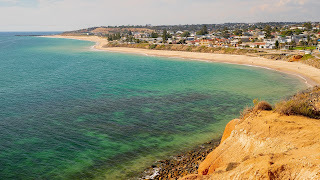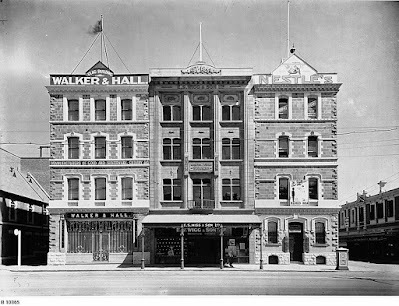Allen Tiller's Blog
October 7, 2025
Suicide After Seeing a Fortune-Teller.

On the 14th of May 1901, the body of Bridget Dunnwas found in Anderson’s Creek. The creek, near the property of LambertChristie, had about 18 inches of water in it. Dunn’s legs were tied together,and her hands fastened behind her back, an obvious murder.
Bridget Dunn was aservant of Mr Lambert and Rosa Christie. She had been in the employ of theChristies for 3 and half years. Lambert Christie was born on Kangaroo Island in1858. With his father, he operated the Kangaroo Island mail service. In 1895,Lambert purchased land surrounding Dalebrook Homestead.Lambert was a member of the Morphett Vale District Council and served asChairperson from 1904 until 1909. He laid the foundation stone for the MorphetVale Institute extension in William Street, Morphett Vale in 1928. The farm wassold in 1932, and the land south of what is now Christie's Creek was subdividedand named Christie's Beach.
Bridget Dunn was described as a cheerful young lady. Inearly May 1901, she visited a psychic and had her fortune told. After that timeBridget’s demeanour changed, and she became morose and low-spirited. Bridgetwas questioned on her noticeable change of temperament, and replied, "Youdon't know what the fortune-teller told me."
Governess of the Christie house, Miss Naughton, last saw Dunn at 9:30 am on Wednesday. She was not reported missing until noon that day when her neglect of her usual duties was noticed. A search was conducted, andMr O.R. Milway found her body in the creek under the bridge.
During an inquest, evidence was submitted that Dunn had beenacting irrationally the morning of her death. She had reportedly made a fireoutside and burned books, papers and old clothing. Dunn had mentioned suicide but in a joking way. The jury brought in the following verdict: "That deceased came to her death bydrowning herself while in a temporary fit of insanity, which was brought on bya hallucination after seeing a fortune-teller."
It seems to me,highly unlikely that Bridget Dunn committed suicide. How would she tie herhands behind her back before drowning herself? If she was going to take her ownlie, other, easier means would have been readily available on a farm in 1901.It seems to me, and this is just my personal opinion, that someone killedBridget Dunn, and we may never know the reason why!
Researched and written by Allen Tiller © 2025.
'A Determined Suicide.', Chronicle. (25May 1901), p. 16.
‘History of Christies Beach,’ ProfessionalsChristies Beach, (2013),https://christiesbeachprofessionals.c....
Bruce Swann, ‘Christies Homestead: Treasures WallExhibit,’ State Library of South Australia, (2009),https://digital.collections.slsa.sa.g....
'After Seeing a Fortune-Teller.', The DailyTelegraph, (20 May 1901), p. 6.
'Suicide After Seeing a Fortune-Teller.', SundayTimes, (26 May 1901), p. 8.
September 2, 2025
Mary Sullivan vs. Madame Valetta – Psychic Fraud?

In 1889, South Australian fortune teller Louisa Valetta wascharged by police for obtaining half a crown by false pretence. Mrs Sullivanhad visited Valetta, who gave her a cup of tea and a quick chat. Valetta thenshuffled some cards and dealt them. She explained Sullivan's fortune by readingthe cards.
The following daySullivan went to the police to have Valetta charged for being a fake psychic.She did not demand the return of her money. The presumption by the police atthe time was that Sullivan had done so out of spite. Magistrate S. Beddommeheard the case and fined Valetta for deceptively obtaining money by pretendingto tell Sullivan's fortune.
Valetta appealed the decision, and thecase was heard in front of Justice Boucaut. Her lawyer, W. V. Smith, presentedthat she had been convicted as ‘she did unlawfully deceive and impose upon oneMary Sullivan by pretending to tell her fortune; whereby she obtained the sumof 2s; 6d.” The grounds of the appeal, that Valetta was not guilty of thecharges, were based on the grounds that there, ‘was no evidence to support the conviction;that the conviction was bad in law; and that the order was bad in law and ultravires’ (beyond the powers).
At the time (1889) legislation in South Australia was basedon English law. One law, Hen. VIII, C.8 stated that it was a felony to practiceconjuration, witchcraft or sorcery to obtain monies, to consume any person inhis body, members, or goods or to provoke any person to unlawful law. Accordingto the South Australian Register (newspaper) reported at the time that the lawwas repealed but reinstated in the 5th year of Queen Elizabeth’sreign, and again during the reign of King James 1 – the law from this timestayed for another 140 years.
The law stated it was punishable bydeath to,
consult with, entertain, employ, feed or reward any wickedspirit with the intent to take up any dead person out of the grave for thepurpose of using the body in any witchcraft, sorcery, charm or enchantment,whereby any person might be killed, wasted, consumed.
Due to people using the law to persecute people they did notlike, it was modified, but still enforced in England, and South Australia in1889. King George II modified the law, abolishing the prosecutions forwitchcraft on the assumption that such a thing did not exist. The law stilloffered protection for people being scammed by those pretending to besorcerers, psychics and fortune tellers, with the punishment of death beingdowngraded to imprisonment or pillory. (Pillory was a wooden device where theheads and arms were placed through holes and locked in place. The prisoner wasthen exposed to public humiliation – and sometimes rotten fruit may be thrownat them.
The Police Act, 15, (1869-70) (An Act to consolidate and amend the Lawrelating to the Police in South Australia.) states, 'Every person pretendingto tell fortunes, or using any subtle craft, means, or device, bypalmistry or otherwise, to deceive and impose upon Her Majesty's subjects.’
The punishment is,
‘Shall be liable to imprisonment for anytime not exceeding two calendar months with or without hard labour.’
Evidence was provided that there was no evidence that Valetta had been paid fora fortune telling. There was no imposition to Sullivan proved, Valetta onlymentioned things that were ‘likely to happen,’ and which were in the realms ofpossibility. By Sullivan not requestingher money returned, the charge was quashed as being presented on false pretenceas there was no evidence that the person received money. Magistrate Boucautstated, to him, it seemed as if two women had been friends and head been tellingeach other’s fortune for some six months or so, daily. That friendshipdissolved, and one sought revenge against another. There was no evidence thatMadame Valetta advertised her services as a psychic, so could not be chargedunder the Police Act for deception. The conviction was overturned.
Researched and written by Allen Tiller © 2025
'THE FORTUNE-TELLING CASE.', The Advertiser,(22 August 1889), p. 5.
'FORTUNE-TELLING.', South Australian Register,(22 August 1889), p. 4.
'FORTUNE-TELLING.', South Australian Register,(22 August 1889), p. 4.
Police Act (No 15 of 33 Vic, 1869-70), SouthAustralian Government, (1870), p. 91.
Police Act (No 15 of 33 Vic, 1869-70), SouthAustralian Government, (1870), p. 91.
'THE FORTUNE-TELLING CASE.', The Advertiser,(22 August 1889), p. 5.
August 5, 2025
Death by Brick
 E. S. Wigg & Son stationers and adjoining buildings in Grenfell St, Adelaide, 1922
E. S. Wigg & Son stationers and adjoining buildings in Grenfell St, Adelaide, 1922
SLSA: [B 10365]
It was August 1921, when ArthurLeonard Brown of 166 Carrington Street, Adelaide, went to work like any otherday. On this day he was employed as part of the work gang building known as Wigg’sBuilding at 63-69 Grenfell Street, Adelaide.
E.S. Wigg & SonLimited began on Rundle Street in 1849, established by Edgar Smith Wigg. Thecompany produced stationery, which it just so happened, that a law had passedin 1849 requiring records to be kept for councils, religious congregations, licensesand taxation. In the 1870’s Wigg & Son also offered school supplies. A newbuilding was erected on Rundle Street in 1880 – which was subsequentlydemolished during the Myer Centre rebuild in the 1990s.
With a growing business in SouthAustralia and Western Australia, the company bought land on Grenfell Street tomeet its storage requirements. They moved into the Grenfell Street buildingin December 1921.
Mr Brown was goingabout his business as a bricklayer on that fateful day. Another bricklayer,Harold Gordon O’Reilly, was also working at Wiggs. O’Reilly was stationed onthe third floor of the building when he the cry of “Under below!” O’Reilly noticed two bricks falling from thefloor above.
Gordon Scroop, another bricklayer wasworking on the third-floor landing, winching up bricks in a barrow. A load ofbricks came up on the winch but was an inch too short to be swung onto thelanding, because of this there was a slight jerking motion to the barrows whichcaused two bricks to come loose and fall. Scroop called out several times with a warning: “Under below!”
Brown had hooked thebarrow of bricks onto the winch that was to go to the third floor. RichardWilliams, the winch driver, set the winch in motion, and both men watched it goup from below. Williams heard the cry of “Under, Below,” but it was too late,he watched as one brick hit Brown in the back of the head, and another slid acrosshis shoulder. Brown was rushed to theAdelaide Hospital where he died later the same day.
An inquest was held a week later at the Education Building on Flinders Street,under City Coroner, Dr Ramsey Smith. Dr Wentworth R.C. Mainwaring deposed thatthe brick had hit Brown in almost the centre of the back of his head. It hadleft a slight cut but had fractured Brown's skull from the top middle of hishead to the base of his skull – this is what killed him.The Coroner found the death to be accidental.
Arthur Leonard Brown was just 29 years of age when theaccident occurred. Brown was buried at the West Terrace Cemetery.
Researched and written by Allen Tiller ©2024
‘Wigg’s Building’, Heritage of the City of Adelaide, Cityof Adelaide, (2001), p. 1., https://d31atr86jnqrq2.cloudfront.net....
'Killed By A Falling Brick', The Express andTelegraph, (29 August 1921), p. 2.
'Killed By Falling Brick.', The Journal, (29August 1921), P. 1.
'Family Notices', Daily Herald, (26 August1921), p. 2.
July 22, 2025
Lightning Strikes - Bagot's Head Station
On November 22nd, 1860, a thunderstorm blew throughthe Kapunda region in South Australia’s mid-north. Three young men were cuttinggrass at Bagot’s Head Station (Koonunga). At about 11am the thunderstorm grewin intensity. The three young men, Rody Young, his younger brother James andThomas Ryan were all killed by lightning.
Thomas Ryan was 26 years old, he was married with three children. RodyYoung was aged 22 years old, and married with two children. James Young wasaged just 14. Thomas Ryan had married a sister of the Young brothers; thefamily lost three men that day.
John Hill deliveredthe sad news to the people of Kapunda. He reported that the men's clothes were stripped from their bodies by a lightning bolt. Hill had been standing near the men at the time of the lightning strike and had been thrown to the ground by the force of thelightning strike.
According to the South AustralianWeekly Chronicle, when the bodies were recovered, they were ‘found to bequite black, and all the clothes were burnt to cinders.’Rody Young and James Young were almost naked, with just strips of clothingcovering their burned bodies. The men’s beards had been burned from theirfaces, and James’s boot had a small hole where the lightning exited into theground through his boot nails.
Dr Blood gave his opinion that the death was caused by lightning. An inqueststated that ‘Death by the visitation of God, through lightning,’ was theofficial cause of death!
'DEATH BY LIGHTNING AT KAPUNDA.', SouthAustralian Register, (23 November 1860), p. 3.
'CORONER'S INQUEST AT KAPUNDA.', SouthAustralian Register, (24 November 1860) p. 3.
'KAPUNDA.', South Australian Weekly Chronicle,(24 November 1860), p. 2.
'CORONER'S INQUEST AT KAPUNDA.', SouthAustralian Register, (24 November 1860) p. 3.
July 15, 2025
Lightning Strikes – Brooks Family

In February 1889, a severethunderstorm blew in over Brookside, near Eudunda. Mrs Brooks decided to send her son to Dutton with two horses to retrieve his sister from school. Theteenager (17) saddled the horses and rode towards Dutton immediately. Hereached his destination safely and helped his 12-year-old sister onto herhorse, and together they began the ride home.
Another daughter of Mrs Brooks wassitting inside the house out of the storm. Thunder cracked overhead andlightning flashed outside. She sat looking out the window wondering how heresister and brother were faring in the weather. Lightning lit the fields nearbyagain, and this time, she noticed lying in a field two horses and what seemedlike to people. She alerted her parents; Mrs Brooks ran to find her twochildren and their horses dead.
A very powerful bolt of lightning hitthe pair as they neared their home. The young male was severely charred fromthe lightning strike and a hole was burned through his horse's saddle, as fired bya gun. He took the severity of the lightning bolt with his sister's only visibleinjury being a black mark on her breast. The horses were found a few yards distance from the teenagers, lyingupon each other. The bodies of the teenagers were disfigured in the fall of thehorses, the girl still holding the reigns of her horse.
William and Charity Brooks buried theirteenagers, William Junior and Ellen at the Truro Cemetery.
Researchedand written by Allen Tiller © 2025
'STRUCK BY LIGHTNING.', Kapunda Herald, (1March 1889), p. 2.
'Family Notices', South Australian Register,(7 March 1889), p. 4.
July 8, 2025
Lightning Strikes – The Death of Mr Carey

It was a Friday afternoon January 25 1901,Thomas Carey, a farmer near Templers, was returning home after visiting Gawler.He was riding in a wagon with six horses. His brother, Jeremiah Carey, anemployee of Mr Flett, had also been in Gawler that day, and rode with hisbrother as far as Flett’s farm near Roseworthy.
Thomas waited with his horses and wagonwhile his brother went into his lodgings and found an overcoat that he gave toJeremiah. Mr Flett invited Thomas to park his wagon at the farmhouse and stablehis horses as a fierce storm had settled in. Thomas declined theinvitation. Jeremiah then changed hisclothes and went with Mr Flett to check on an overflowing drain. The men walkedfor a little while but noticed Thomas's wagon was sitting idle alongside theroad. They walked over to it and found all six horses and Thomas dead.
Authoritieswere alerted, with Mounted Constable Grosser the first on the scene. He foundThomas Carey sitting in an upright position, his body leaning back on the hayframe. His feet were resting on the shafts. Thomas’ left leg was scorched abovethe ankle, as was the left side of his neck and face. His moustache and hair onthe left of his body was badly singed. Thomas’body had many small burn marks, especially across his torso. His hat had beenblown off his head and was lying 200 yards away.
The horses were lying dead where theyhad stood, with no apparent electrical or fire damage. The wagon was alsounscathed.
Mr A.G. Both, J.P. stated that an inquest was not required and approved for the burial of the man and his horses. The horses were buried in a 10-foot-deep,former waterhole on the property of James Dingle.
ThomasCarey was buried at the Willaston Cemetery. The Bunyip newspaper reported thatthe funeral procession was one of the longest ever seen in the district at thetime, with over 100 vehicles following the hearse.
Researchedand written by Allen Tiller © 2025
'STRUCK BY LIGHTNING.', Border Watch, (30January 1901), p. 1.
'Killed by Lightning.', Bunyip, (1February 1901), p. 2.
'Killed by Lightning.', Bunyip, (1February 1901), p. 2.
July 1, 2025
Lightning Strikes – Penola Shepherds

In January 1907, James and his older brotherAlex Patterson were mustering sheep on their uncle's farm near Penola in the southeast of South Australia. They counted the sheep they had mustered and realized the count fell short, so they went to look for the lost sheep.
As they rode their horses through thepaddocks, a storm blew in. The two boys took shelter under the tree. The treeproved to be insufficient to shelter both boys and their horses, so Alec rodeon a little further to find another tree to shelter underneath.
James could see his brother when a flashof lightning filled the gloom of the storm. James watched his brother’s horsefall. He ran to his brother to find him sitting upright with his pocketbook inhis hand, as he had been counting sheep when the lightning struck. Next to himwas his dead horse and his dead dog. He then ran to the nearest house andalerted them to the tragedy.
Mounted Constable Carter, William Patterson(Alex’s uncle) and Dr Magee from Penola made their way to the site of thetragedy.They discovered Alex’s body, his clothes were torn, his right trouser leg wasentirely split, and his boots torn to shreds. His body had been seared in someplaces and his hair singed.They loaded the body onto a cart and brought it back to Penola.
A report onthe incident was published in the Border Watch newspaper as follows,
"I have the honor to report that William Patterson, J.P. reported to me at 5.30 p.m., on the 26th inst., that his nephew, AlexanderJohn Patterson, son of James Patterson, of Suthledge, was killed by lightning onthe Victorian border, near Lake Mundi. I left immediately in company with Dr.Magee and Mr. W. Patterson, and found that, the deceased, his horse, and hisdog were all killed near a gum tree, under which they had taken shelter fromthe storm.
The horse had evidently fallen wherestruck, and it was bleeding from the ears and was dead. The sheep dog was lyingdead close to the deceased, and its hair was singed. The ground was torn upround where the deceased lay. He had the body brought into Penola.
James Andrew Patterson, aged 13 years, statedthat between 3 and 4 o'clock on Saturday, he was mustering sheep with hisdeceased brother, who was 17 years of age. They found they were short in number,and were searching for the missing ones when a heavy storm came on, and they bothtook shelter under trees. The deceased was sitting under one tree about a chainaway from the one he was under. He had his horse close to him, holding it bythe bridle, and his pocket book in his hand counting up the number of sheep. Aflash of lightning came; and he saw his brother's horse fall. He ran over,and found his brother sitting as before with his pocket book in his hand. Hespoke to him, but got no answer. He spoke to him again, and found he was dead,and also the horse and dog. He immediately went to the nearest neighbours, toldthe, what had happened, and asked for help.
Dr. C.C. Magee reported on the eveningof the 26th inst. He, in company with M.C. Carter of Penola,inspected the body of Alexander John Patterson, aged about 17 years, found deadunder a tree, 114 miles from Penola, on the Casterton Road.
He found the right leg of the trousersbadly torn from the middle of the thigh downwards. The right boot wascompletely torn off the foot, only the heel and sole of the boot being. left.The toe of the left boot was torn open. About half a dozen holes were burnt inthe singlet, and a small hole was burnt in the soft felt hat.
On examination of the body he found the hairon the back of the head and ears singed, about half a dozen small burns on theback between the shoulder blades corresponding with the holes in the singlet, abruise about an inch square between the eighth and ninth rib on the left side, thepubic hair singed, a burn about the size of the palm of a hand on front of the rightleg between the knee and ankle, a small burn under the right big toe, and the hair singed on the right leg up to theknee.
From these appearances he considereddeath to have been caused by lightning stroke, and to have been instantaneous.
Alexanderwas buried in the Penola cemetery, with the Reverend D.A. Souter ministeringover the procession.Alexander is buried alongside his uncle, Thomas MacDonald, who died just twoweeks prior.
Researchedand written by Allen Tiller © 2025
Youth, Horse, And Dog.', The Register, (28January 1907), p. 5.
'TRAGIC DEATH AT PENOLA.', The South EasternTimes, (29 January 1907), p. 2.
'KILLED BY LIGHTNING.', The Register, (29 January1907), p. 4.
'THUNDERSTORM HEAR PENOLA.', Border Watch,(30 January 1907), p. 2.
‘Patterson’, Cemetery Search, Wattle Range Council,(2025), https://www.wattlerange.sa.gov.au/liv....
'THUNDERSTORM HEAR PENOLA.', Border Watch,(30 January 1907), p. 2.
June 24, 2025
Lightning Strikes – The Death of Bertha Cook.

On Monday 4 February 1929, 25-year-old BerthaCook was doing her washing in her backyard, while her son Lloyd played nearby.Her husband Fred, a returned soldier and fruit grower, was working in the frontyard. The sky was overcast but did not look threatening. As thunderstruck abolt of lightning struck Bertha in the head. Lloyd was struck by the shockwavethat followed, but through his daze, managed to get into the front yard of theproperty and alert his father that something was wrong with Bertha.
Fred came into the backyard to find Bertha’sclothes ablaze. He put the fire out andtried to revive his wife, but she was dead. He then ran for medical help. Lightninghad struck her on the shoulder, her shoulder and legs were ‘charred tocinders,’ and her shoes were ‘torn from her feet like tissue paper.’
Researchedand written by Allen Tiller © 2025
'Latest News.', West Coast Recorder, (7February 1929), p. 2.
'WOMAN KILLED.', The Advertiser, (7February 1929), p. 13.; 'Woman Killed by Lightning.', The NarracoorteHerald, (15 Feb 1929), p. 4.
June 17, 2025
Lightning Strikes – Islington.

In December1895, sisters, Mrs King and Mrs Daly were walking along the North Road near theReepham Hotel at Islington when lightning struck. The two ladies were thrown tothe ground unconscious. When both ladies were roused, neither could use theirlegs. Mrs King was taken into the Reepham Hotel where it was revealed she hadbeen severely burned across her body, her hair had been singed, and her bootsblown from her feet.
Mrs Daly was far more fortunate, escaping with a severe shock only. A horsethat was standing not far from where the two women were struck, was killedinstantly.
The ladieswere attended by well-known Adelaide Doctor C.G. Lermitte. Dr Charles GowerLermitte was born in Canada in approximately 1862. He was educated in medicineat Richmond England.
On 28 May 1889, Charles married AugustaKatherine Winifred Scott at Walkerville, South Australia.
In 1890 thecouple moved to Deloraine in Tasmania where Charles worked as a Doctor.In 1900, Dr Lermitte was working from Olive House, Gilberton, South Australia. In October 1920 it was reported in theAdelaide Observer that Doctor Lermitte had committed suicide at his home inKent Town. He was found dead in his bed by his wife. It was concluded he hadtaken prussic acid, what we know today as hydrogen cyanide.
During an inquest into the doctor’s death, it was shown that he had been in asuicidal state for some time prior. A letter was produced at the inquest in DrLermittes hand, which stated he had previously taken 43 grains of sulphate ofmorphia, enough to kill 3 or four men, but he had barely felt affected.
The coroner was surprised at the rulingof temporary insanity and questioned the jury. Several of the Coroner's ownfriends were intimately acquainted with the doctor and did now think he wouldtake his own life.
CharlesGower Lermitte, M.R.C.S. Eng. & L.S.A. Lond. was 40 years old at the time of his death. Heowned medical practices at Gilberton, Kent Town and Norwood.Dr Lermitte was buried at Nailsworth Cemetery.
Researchedand written by Allen Tiller © 2025
'The Sunbeam Society.', Evening Journal,(7 December 1895), p. 4.
'STRUCK BY LIGHTNING.', The Advertiser, (7December 1895), p. 5.
Charles Gower Larmitte, District 14, Richmond, Surrey,Class: RG11; Piece: 844; Folio 844, GSU roll: 1341200. EnglandCensus, (1881), p. 29.
Lermitte – Scott, Australia Marriage Index,1788-1949, Vol. 159, (1889), p. 1130.
Medical Directory, Tasmania PO Directory, (Wise),(1890-91), Australia, City Directories, (1891), p. 390.
Lindsay, Practitioners Resident Abroad, The MedicalDirectory (1900), p. 1799.
'THE LATE DR. LERMITTE.', Adelaide Observer,(25 October 1902), p. 31.
'DR. C. LERMITTE.', The Express and Telegraph,(17 October 1902), p. 1
Dr Charles Gower Lermitte, Find a Grave, (1902), https://www.findagrave.com/memorial/2...
June 10, 2025
Lightning Strikes – The Tragic Death of A.H. Chapman.

On October 7, 1907, 21-year-old Alfred HaroldChapman of Weaver’s Lagoon, was working on the farm of Mr James Latty nearYorketown.Chapman was droving stock from a paddock heading back towards the farmhousewhen a storm passed overhead. Lightning erupted, with one bolt striking Chapmanas he rode his horse.
A report into the lightning strikestated that the lightning entered Chapman through his head, splitting his hatin two, and blowing its remains over 12 feet away. The lightning traveled downthe side of his head, burning his face, ear and neck, before burning throughpatches of skin on his chest and legs. Most of his shirt and other clothingwere found over 12 yards away (approx. 10.5 metres) from his corpse. Chapmanwas holding a dead rabbit in his hand, which had been caught by the dog whichaccompanied him – the dog remained unharmed.
The saddle on which Chapman was riding had a hole burned through it. There werelightning marks on the horse’s shoulder, and down its forelegs towards itshooves. Despite the thunderstorm, no rain fell on the dead man on horse.
'body was transported back to Adelaide. He was buried at Clarendon Cemetery,near his family home. He had been at the Yorketown farm only a few weeks.
Researchedand written by Allen Tiller © 2025
'TELEGRAMS.', The Narracoorte Herald, (8October 1907), p. 2.
'Yorketown', Yorke's Peninsula Advertiser,(11 October 1907), p. 3.
'KILLED BY LIGHTNING.', The Register, (8October 1907), p. 9.
'Yorketown', Yorke's Peninsula Advertiser,(11 October 1907), p. 3.



